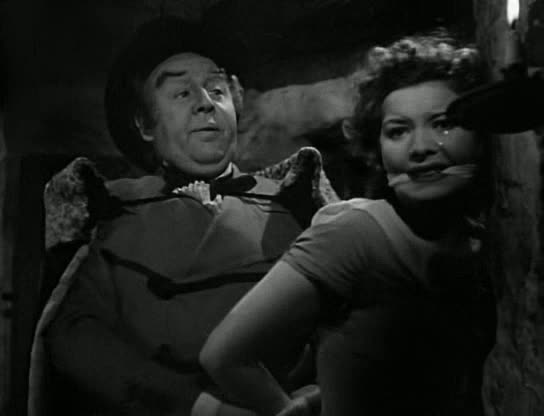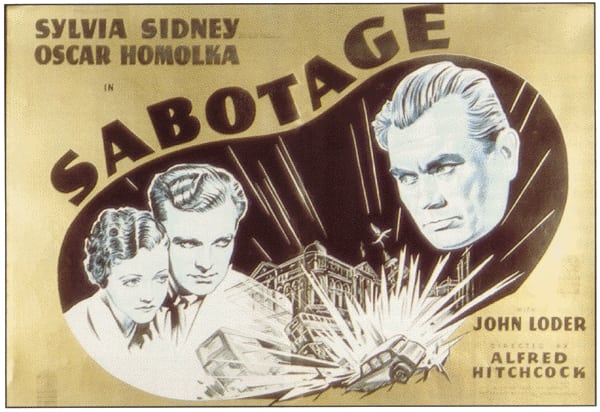Jamaica Inn (1939)
Directed by: Alfred Hitchcock
Written by: Alma Reville, Daphne Du Maurier, J.B. Priestley, Sidney Gilliat
Starring: Charles Laughton, Hay Petrie, Horace Hodges, Maureen O'Hara
UK
AVAILABLE ON DVD
RUNNING TIME: 104 min
THE HITCHCOCK CAMEO: None
REVIEWED BY: Dr Lenera, Official HCF Critic
A ship runs aground on the Cornish coast by Jamaica Inn, somebody having extinguished the beacon, and some men kill all the surviving sailors and loot the cargo. Mary Yellen, the orphaned niece of Joss Merlyn the innkeeper, is heading for Jamaica Inn to live there but the carriage driver refuses to stop there, instead dumping her outside the house of Sir Humphrey Pangellan, who takes her to her destination. There, Joss, who immediately tries to push himself on Mary, seems to have her aunt under the thumb, and the whole inn feels like a place of evil. Mary finds out that Joss is the leader of the gang of smugglers who have been robbing ships. She sees them trying to hang one of their members, Jem Trehearne, for stealing money, and decides to save him….
Generally regarded as one of Hitchcock’s failures, Jamaica Inn is one strange film, but in this case strange doesn’t really mean good, though it is still reasonably entertaining if you don’t attempt to take it seriously. Watching this costume melodrama, it’s difficult to see Hitchcock’s touch in it and it’s obvious he dashed it off. It should be an exciting thriller, albeit more of the Saturday Morning Serial kind than anything else with its Pauline-like heroine discovering smugglers in her new home, but it’s really rather pedestrian, Hitchcock only occasionally seeming to have faith in the material. The entertainment value comes more from its ridiculous situations, its stunning black and white photography which along with the constant wind blowing gives it quite a dark, forbidding atmosphere, and star Charles Laughton, with his false eyebrows on backwards, having fun. Hitchcock said he was never comfortable with costume melodrama and this film certainly proves it, though he would do much better with his next one just over a decade later….but more on that when I come to it.
Hitchcock accepted an offer from producer David O’ Selznick to make four films with him in America, and a film about the Titanic was talked about, but this never got off the ground, so Selznick optioned a novel that was just about to be published, Daphne Du Maurier’s Rebecca. This was decided as Hitchcock’s first American film, but he still had time to kill, so was offered another Du Maurier book, Jamaica Inn, by producer Erich Pommer. The real person in charge though was actor Charles Laughton, whose production company was making it. Sidney Gilliat and Joan Harrison, with the usual help from Hitchcock and Alma Reville, rewrote Clemence Dane’s script, which followed the book reasonably well but made the romantic interest from the younger brother of the nasty Joss into a cop in disguise. However Laughton switched from playing Joss to playing Pengallan the preacher in charge of the smuggling operation, and thereby set about constantly beefing up his part, even getting J.B. Priestley to write dialogue for him, ab-libbing some himself, and changing the revelation that he was a villain from around half way through to near the beginning. Then they changed him to a justice of the piece to appease the censors [villainous priests a no-no in the US]. Laughton infuriated Hitchcock by doing nothing for weeks to ‘feel’ his character while he shot around him, until Laughton came on set with a recording of a waltz which he would play and walk in time to. Small wonder that Hitchcock just wanted to get it over with, but the film was a hit, despite critics and Du Maurier disliking it. For some reason, most US DVDs miss a tiny section just after half way, omitting Jen telling Pengallan he is a cop.
The opening scene of the ship being lured onto the rocks and the smugglers rushing down to slaughter the crew is vivid and very well pulled off, the cutting from a quite impressive model of the ship to the actors trying to steer it to safety and the smugglers on the rocks, all in Elstree Studios’s huge water tank, being almost seamless. The brutality of the killing of the sailors, though bloodless, is quite shocking, especially when one guy seems to survive and a smuggler goes to knife him off-screen. Then we cut to Mary, and after a lengthy sequence at Pengallon’s house which, as with many of Laughton’s scenes, is extended way past its proper length, she arrives at Jamaica Inn. They didn’t use the real Jamaica Inn, which I’ve been to and is a really creepy and sinister place, but it looks foreboding enough and full of enough shadows and dark corners, while the outdoor sets of the jagged coastline are rather convincing and certainly enhance the somewhat gloomy feeling. We get a snapshot portrait of an abusive marriage when Mary meets Joss and her aunt Patience, and in some ways this couple are the moral centre of the film, the story eventually coming to hinge on whether she will turn against her violent, lecherous hubby, whom with misplaced devotion she loves dearly. In fact, if there had been even more of these two and less of Laughton, the film may have worked much better.
In any case, it soon becomes mostly about Mary, and the smuggler [but undercover cop] fleeing the bad guys. There’s a fine escape from the inn and chase to the shore, where matters really do seem to be getting exciting with the two trapped in a cave, but then the pace suddenly dawdles and doesn’t really recover. The constant hide-and-seek, with people always dodging out of the way of someone else, gets rather funny, and you wonder if it wouldn’t have been better if they played up the comic side, but instead it’s all taken quite seriously except for the some of the scenes involving the smugglers, who, except for Joss, never inspire any menace and, though nicely characterised with the amusing addition of a priest [perhaps a nod to Pengallan’s original profession], tend to sound more Cockney than Cornish. Of course hero and heroine spend more time with Laughton, the audience supposed to be in suspense as to when he will reveal his true colours to them [the way this is done in the book is much better, with Mary finding a strange drawing by Pengallan], than being chased by the smugglers. Eventually the cops turn up and mundanely arrest the smugglers without a fight. This is of course to give Pengallan the big final scene. Having kidnapped Mary, he threatens her, then climbs the mast of the ship and jumps off it.
The Hitchcockian touches are few and far between. Perhaps the best scene is Mary’s attempt to save Jem from the noose, breaking away the plaster on her bedroom room and reaching through the hole to the beam beyond it with a table knife. A bit on a carriage has a few seconds of shaky camera footage and Pengallan’s jump has some nice high angles, but for the most part the care and attention that had been exhibited in Hitchcock’s previous few films is absent. It really is Laughton’s show, and he’s certainly fun to watch, ranting and raving whilst mincing about with those ludicrous eyebrows. He has some great moments where his condescending to those around him goes unnoticed. He’s also unashamedly lecherous, and the scene where he ties and gags Mary has a clear sexual charge to it, but never can you take the character seriously. Contrasted with Pengallon is the one character who provides some real fear. Joss Merlyn is a convincingly horrible piece of work, walking like the Frankenstein Monster, acting like he’s perpetually drunk, and seemingly about to punch his wife at any moment. Leslie Banks is scary here, but the huge difference between the two villains further unbalances a film which already doesn’t really seem to know what it’s doing. Its biggest failing though is that one never really gets a feeling of what’s at stake, and this develops into a sense that, in the end, they didn’t care too much and just decided to have what fun they could. Where somebody is about to mention the name of the villain-in-chief and is shot before he can utter the words, it doesn’t even make sense as everyone knows who the villain is, but it’s used anyway because it’s a cliché in this sort of film.
Maureen O’Hara, whom Laughton took to Hollywood with him after this film and made her a star in The Hunchback Of Notre Dame, is a most energetic heroine, and Robert Newton, later to play Long John Silver, gives it his all as the hero, making something interesting out of a bland character. As well as Banks, you get Wylie Watson, Frederick Piper, Basil Radford, Clare Green and George Curzon, all faces from earlier films, appearing for one last hurrah before Hitchcock left for America. Eric Fendy’s title music is full of melodramatic fury but the film contains no actual score. Jamaica Inn contains some good work, but it’s fatally flawed and compromised, a good case of a star overruling a director to bad effect, though its problems run deeper than that. It remains kind of enjoyable, though not much more. It certainly doesn’t deserve being an entry in Randy Dreyfuss and Harry Medved’s book The Fifty Worst Movies Of All Time, being not even Hitchcock’s worst sound film, though it’s in the bottom ten. It was remade as a two part TV movie in 1982.











Be the first to comment